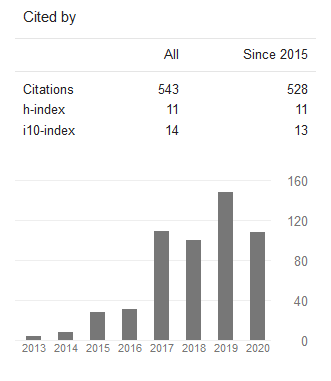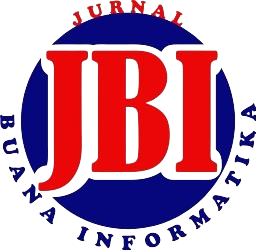Perencanaan Arsitektur Teknologi Informasi Kelurahan Babau Menggunakan TOGAF ADM
DOI:
https://doi.org/10.24002/jbi.v12i2.4660Abstract
Abstract. Information technology architecture planning for Baubau Village using TOGAF ADM. Babau Village is a village located in Kupang Regency, East Nusa Tenggara Province. Currently, Babau Village has implemented information technology as a centre for information and administrative services. To improve the quality of service to the community, existing information technology needs to be further developed because the amount of information in the system will continue to increase along with population growth. The problem faced if information technology is not developed is a system performance problem. For further development to be more focused, research on an information technology architecture design for Babau Village. The design using TOGAF ADM is a blueprint and a roadmap for the development of advanced information technology services. The aim is that the existing business processes within the Babau Village related to information and administrative services continue to develop according to the needs of the community and the organizational management of Babau Village.
Keywords: enterprise architecture planning, TOGAF, ADM, Babau Village
Abstrak. Kelurahan Babau adalah sebuah kelurahan yang terletak di Kabupaten Kupang, Provinsi Nusa Tenggara Timur. Saat ini Kelurahan Babau sudah menerapkan teknologi informasi sebagai pusat pelayanan informasi dan administrasi. Demi meningkatkan kualitas pelayanan kepada masyarakat, teknologi informasi yang ada perlu dikembangkan lebih lanjut karena jumlah informasi yang ada dalam sistem akan terus meningkat seiring pertumbuhan jumlah penduduk. Masalah yang dihadapi apabila teknologi informasi tidak dikembangkan ialah masalah kinerja sistem. Agar pengembangan tahap lanjut lebih terarah, penelitian mengenai sebuah perancangan arsitektur teknologi informasi untuk Kelurahan Babau. Perancangan yang menggunakan TOGAF ADM tersebut merupakan blueprint dan juga roadmap untuk pengembangan pelayanan teknologi informasi tahap lanjut. Tujuannya ialah proses bisnis yang ada didalam Kelurahan Babau terkait pelayanan informasi dan administrasi terus berkembang sesuai dengan kebutuhan masyarakat dan pengurus organisasi Kelurahan Babau.
Kata Kunci: arsitektur teknologi informasi, TOGAF, ADM, Kelurahan Babau
References
P. A. Nani, P. Batarius, N. Magdalena, and R. Mamulak, “Platform Digital Kelurahan Babau,” no. September, 2020.
B. P. Statistik and K. D. Negeri, “HASIL SENSUS PENDUDUK 2020 Berita Resmi Statistik No. 7/01/Th. XXIV, 21 Januari 2021 KEMENTERIAN DALAM NEGERI Hasil Sensus Penduduk 2020 Jumlah,” 2021.
K. Surendro, Pengembangan rencana induk sistem informasi. Informatika, Bandung, 2009, 2009.
TOGAF®, “The TOGAF® Standard, Version 9.2.” [Online]. Available: https://pubs.opengroup.org/architecture/togaf9-doc/arch/.
R. Ansyori, N. Qodarsih, and B. Soewito, “A systematic literature review: Critical Success Factors to Implement Enterprise Architecture Implement Enterprise Architecture,” Procedia Comput. Sci., vol. 135, pp. 43–51, 2018.
F. Nikpay, R. B. Ahmad, B. D. Rouhani, M. N. Mahrin, and S. Shamshirband, “An effective Enterprise Architecture Implementation Methodology,” Inf. Syst. E-bus. Manag., vol. 15, no. 4, pp. 927–962, 2017.
D. Dang and S. Pekkola, “Systematic Literature Review on Enterprise Architecture in the Public Sector,” 2017.
C. Kearny, A. Gerber, and A. Van Der Merwe, “DATA-DRIVEN ENTERPRISE ARCHITECTURE AND THE TOGAF ADM PHASES,” pp. 4603–4608, 2016.
G. F. Nama and D. Kurniawan, “An Enterprise Architecture Planning for Higher Education Using The Open Group Architecture Framework ( TOGAF ): Case Study University of Lampung,” in 2017 Second International Conference on Informatics and Computing (ICIC), 2017.
G. J. P. Negara and A. W. R. Emanuel, “Enterprise Architecture Design Strategies for UGK Using TOGAF ADM,” no. October, 2019.
O. T. Prayitno, “Planning of Higher Education Information Technology Strategy Using TOGAF ( A Case Study at AMN Cilacap ),” vol. 2, no. 1, pp. 67–79, 2019.
I. Santikarama, “Designing Enterprise Architecture Framework for Non-cloud to Cloud Migration Using TOGAF,” no. July, pp. 20–21, 2016.
M. Ibrohim and A. S. Girsang, “DESIGNING IT BLUEPRINT WITH TOGAF FOR INFORMATION TECHNOLOGY,” vol. 10, no. 03, pp. 837–854, 2019.
T. Tambo, J. Bargholz, and L. Yde, “EVALUATION OF TOGAF AS A MANAGEMENT OF TECHNOLOGY FRAMEWORK,” 2016.
S. D. Oktalia and R. N. Shofa, “Perencanaan Arsitektur Sistem / Teknologi Informasi Menggunakan Framework TOGAF ( Studi Kasus : Dinas Perpustakaan dan Kearsipan Daerah Kota Tasikmalaya ),” pp. 63–74, 2019.
D. Napitupulu, M. Syafrullah, I. R. H. T. Tangkawarow, and J. Waworuntu, “Applying TOGAF for e-government implementation based on service oriented architecture methodology towards Good Government Governance Applying TOGAF for e-government implementation based on service oriented architecture methodology towards good government,” in 4th International Seminar of Mathematics, Science and Computer Science Education, 2018.
H. Qurratuaini, “Designing enterprise architecture based on TOGAF 9 . 1 Framework,” in 1st International Conference on Engineering and Applied Technology (ICEAT), 2018.
R. Hermawan and I. Sumitra, “Designing Enterprise Architecture Using TOGAF Architecture Development Method,” IOP Conf. Ser. Mater. Sci. Eng., vol. 662, p. 42021, 2019.
“Laravel Framework.” [Online]. Available: https://laravel.com/.
“Vue.js.” [Online]. Available: https://vuejs.org/.
Downloads
Published
Issue
Section
License
Copyright of this journal is assigned to Jurnal Buana Informatika as the journal publisher by the knowledge of author, whilst the moral right of the publication belongs to author. Every printed and electronic publications are open access for educational purposes, research, and library. The editorial board is not responsible for copyright violation to the other than them aims mentioned before. The reproduction of any part of this journal (printed or online) will be allowed only with a written permission from Jurnal Buana Informatika.
This work is licensed under a Creative Commons Attribution-ShareAlike 4.0 International License.










